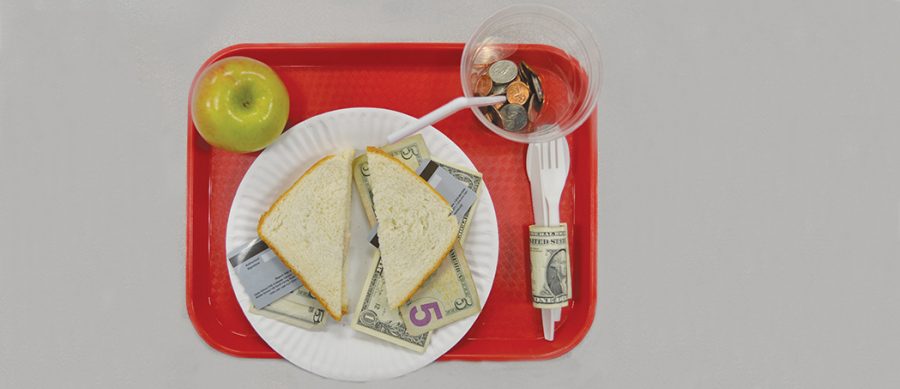Cafeteria cashier Phairot Janthep’s daily routine consists of greeting students, some by name, who come in daily to buy their lunches, snacks and drinks. Seeing everyone who comes to the cafeteria, Janthep said he has an insider view of how much students actually spend on a daily basis.
“There’s been some who spent $30 a day and sometimes like $20,” Janthep said. “They eat like that every day.”
Although her spending habits at school have changed with her senior privileges, which allow her to leave campus during the school day, Rachel Grode ’19 said that it can be hard for her to grasp how much she is actually spending because her parents end up paying the bill, Grode said.
“I definitely notice how much I’m spending, but I feel like with my school ID, I don’t really care because it creates a false pretense that it is not really money and it’s just scanning,” Grode said.
While cash transactions occur on campus at certain food trucks or fundraisers, the majority of spending is facilitated by the school’s digital accounting system, Didax. Using scannable ID cards speeds up transactions and allows for a digital log of student spending on a daily, weekly, monthly or yearly basis, accessible to both parents and students.
The bookstore and the cafeteria are the two main places on campus where students spend money, Director of Middle School and Upper School Bookstore Operations Tina Cleveland said. She said she has seen the majority of students purchase responsibly.
“I would say that probably about 80 percent of the student population is very concerned about how much money they’re spending because I think families now are talking more to their children about what it costs to provide for them,” Cleveland said.
For some fundraisers on campus, the minimum charge for personal accounts is $10, and students can opt to bring cash to pay smaller amounts. Nevertheless, Cleveland thinks it is best to minimize cash transactions, especially when purchasing from the bookstore, to avoid any complications.
“Kids lose stuff way too much here to come to school with money,” Cleveland said. “[Didax] is very secure, I believe, but if you lose your wallet, it is gone. When you start dealing with cash and all that kind of stuff, you have to wait for change and it just drags out a little bit.”
There is no specific class or program on campus designed to teach students about finance, a skill that Interdisciplinary Studies and Independent Research Teacher and Counselor Michelle Bracken said she believes is a valuable capability in a student’s development.
“I do think [personal finance] is a skill that, regardless of kids wanting it, would be something worth teaching.” Bracken said. “I’m not sure there’s a responsibility [to teach it], but I don’t think it would be a bad thing to incorporate [into the curriculum] somehow.”
However, there are a few systems in place to help out families financially when necessary. For example, students on financial aid receive $1,300 per year in a draw account that covers food from the cafeteria as well as certain items deemed necessities from the bookstore, like textbooks and school supplies. Anything discretionary, such as class sweatshirts, come out of pocket. Additionally, any parent can request a budget for their student, regardless of if they are on financial aid, Chief Financial Officer David Weil said.
“I don’t know how widely known these capabilities are, but we do have the ability in a rather flexible manner to put limits on what students are able to spend,” Weil said. “At the moment, it’s typically done in relation to cafeteria purchases on either of our campuses, but on a weekly, monthly, or even yearly basis we can put in limits at the request of parents or guardians.”
While students can access a specific log of their spending history at both the bookstore and cafeteria on the student portal, some students, such as Anna Katz ’20, think that the school could do more to make this information more accessible.
“I spend more at school just because I’m here everyday and I spend money here much more often,” Katz said. “But, I think it would be nice to see how much you’re spending on the ID app.”
Discussions about the use of the 20th century credit-based economy have started in both World & Europe II and AP US History classes, Director of Financial Aid & history teacher Greg Gonzalez said. He believes encouraging this dialogue will help students become more knowledgeable about using a credit or ID card.
“Many of us make that segue pretty easily and say, ‘Look, here’s what happens when you use a credit card. You’re actually borrowing money to purchase something in the present,’” Gonzalez said. “So, hopefully students view their ID card in a similar way so they know that their card represents money.”
In a study from 2012 conducted by TNS, a marketing company, on behalf of the multinational bank ING Direct, 28 percent of surveyed teens in the United States recognized budget management as a necessary skill of adulthood, and 83 percent felt that they were not learning the skills they needed to maintain financial stability in the future. Similarly, 50.74 percent of 331 polled Upper School students said they are aware of how much they spend at school, but only 39.27 percent actually have conversations with their parents about their spending.
Even so, Gonzales said he believes that it is not the school’s responsibility to teach the students about financial independence. There are certainly ways that students can manage their own money at school, but that doesn’t mean parents shouldn’t be talking about it as well, Gonzales said.
“The school provides the service of food and merchandise and discretionary purchases for convenience,” Gonzalez said. “Students don’t have to pack a lunch, [but] of course they can. We provide refrigerators for students to store food, but many prefer the convenience of our cafeteria.”
While students from financially stable households might not have to worry as much about spending at school, discussions about those who do have concerns cannot be ignored, Bracken said.
“We used to have food fights here sometimes, and it used to make me really angry,” Bracken said. “People bring their lunch a couple of days a week because they can’t afford the week of food here, and they’re wasting it. But that’s not in everybody’s perspective. When you’re talking about these things, you can’t not talk about the fact that there are some people who have more of a financial awareness because they have to, not because they want to.”































